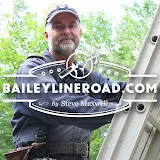0:00
In this video I want to talk to you about the final stages of a distressed finish process
0:07
That's what I've got going on the sample here and that final stage is sealing
0:11
Now before I explain what that is and why it's necessary I just want to recap a little bit
0:16
In a previous video I showed you how I apply this distressed paint finish
0:21
In this case the paint portion is Rust-Oleum's chalked paint and I've applied it over a stained surface on just a piece of construction grade spruce
0:31
that I've planed and sanded and got ready. Here's what we've got. It looks nice
0:37
We see some of the darker areas showing through. That's the whole idea of a distressed finish is that you simulate wear
0:45
It looks nice in its own way and it also just continues to look better as real wear kicks in
0:50
But there is one more step and that's sealing the surface. The reason for that is because any kind of distressable paint is quite soft
0:59
As I said in the previous video when I was sanding this it just turns to powder right away
1:04
which is great for a distressable finish but it's certainly not what you want in a modern paint finish for your house
1:11
In fact it's not even what you want on a piece that has distressed finish on it
1:16
because you want to seal that extra soft paint and just give it a better chance to survive
1:22
and not rub off on your clothes or your hands or something like that
1:27
So there are different ways to seal, different distressable paint companies like milk paint companies or manufacturers of chalked paint
1:37
They sell different things like a wax polish you can put on
1:41
Some people might want to put on urethane. I've tried all those things and nothing works nearly as well as a coat of wipe-on poly, one coat
1:51
Normally you'd apply at least three or four coats if you were using nothing but wipe-on poly
1:58
But for this, since it's just for sealing, that's all we need
2:02
Wipe-on poly is a Menlax product. Essentially it's very thin urethane and it's to be used something like you'd use stain
2:13
So you put some on and you more or less rub it all off
2:17
You're only relying on the stuff that soaks in. So I'm just going to put a little bit on here and show you how it works
2:25
Now besides protection, there is another advantage to sealing. And you're about to see what I mean
2:34
It actually makes the surface look much better, especially when you have a high contrast situation like this with white chalked paint over top of a dark stain
2:46
Now we've got a nice contrast going on here now but watch this
2:51
Watch this when you put some on. It just really makes it pop, doesn't it
2:57
Doesn't that look nice? Like I said, thin coat and one only is really all you need
3:14
I like to finish up by just continuous passes to even things out
3:22
There, that's it. So protected, sealed, it's going to behave itself better in terms of actual use
3:31
And in this case, it even brings out the contrast and it looks better
3:35
So there you go. Finished distressable paint sample


